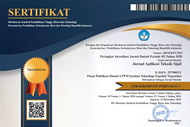Initial Evaluation on Microwave Incinerated Rice Husk Ash (MIRHA) Foamed Concrete Using Neural Network
Abstract
The purpose of this study was to determine whether foamed concrete could achieve a strength requirement for structural application, while retaining its characteristics of low density, flowing workability and self-compacting. This investigation was focused on both designing compositions foamed concrete with pozzolanic material affect that has strength and density according to ASTM C 330. Neural network modelling, as observed, could enable the application of the mix proportion of foamed concrete to reach the compressive strength more than 17 MPa in which density was at 1400 kg/m3 with s/c of 0,5. 1600 kg/m3 with s/c 0,75 and 1800 kg/m3 s/c = 1. The neural networks model could be used as an alternative model in developing the tools to predicting the foamed concrete strength
Keywords
Full Text:
PDFReferences
A.M. Neville. (1995). Properties of Concrete, 4th ed., Longman Essex. England.
Bayuaji Ridho and Fadhil M N., (2008). Prediction of Compressive Strength for Foamed Concrete Using Neural Network. National Postgraduate Conference. Malaysia: UTP.
Kearsley EP, & PJ Wainwright. (2001). The Effect of high fly ash content on the compressive strength of foamed concrete, CemConcr Res 31, 105-112.
Kusbiantoro Andre. (2007). The Effect of Microwave Incinerated Rice Husk Ash (MIRHA) On Concrete Properties. Master Thesis. Malay¬sia: Universiti Teknologi Petronas.
Mehta, P. K., (1992). Rice Husk Ash-A Unique Supplementary Cement Ma-te¬rial. Advances in Concrete Technology, Ed. By Malhotra, CANMET. Ottawa, Canada.
Moyad, Al. Khalaf and Hana A. Yousif. (1984). Use of rice husk ash in concrete, Int J Cement Compos Light Weight Concrete 6, pp. 241–248.
M.R. Jones and McCarthy. (2005). Preliminary views on the potential of foamed concrete as a structural material, Magazines of Concrete Research, 57, No1, February, 21-31.
MS Hamidah, I Azmi, MR A Ruslan, K Kartini, NM Fadhil. (2005). Optimisatiom of Foamed Concrete Mix of Different Sand Cement ratio and Curing Conditions, Proceeding from the int. Conference ‘Global Construction: Ultimate concrete opportunities’, Dundee, 5-7 July 2005, Thomas Telford.
PAN Zhihua1, Fujiwara Hiromi, Wee Tionghuan. Preparation of High Performance Foamed Concrete from Cement, Sand and Mineral Admixtures. DOI 10.1007/s11595-005-2295-4.
Paul Klieger and Joseph F. Lamond. Significance of Tests and Properties of concrete and concrtemaking materials. ASTM STP 169C.
Van Breugel, K., (1991). Simulation of hydration and formation of structure in hardening cement-based materials. Ph.D thesis submitted to Deflt technological Institute, Netherlands.
DOI: http://dx.doi.org/10.12962/j12345678.v11i2.2590
Refbacks
- There are currently no refbacks.

Jurnal Aplikasi Teknik Sipil by Pusat Publikasi Ilmiah LPPM Institut Teknologi Sepuluh Nopember is licensed under a Creative Commons Attribution-ShareAlike 4.0 International License
Based on work at https://iptek.its.ac.id/index.php/jats




